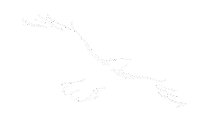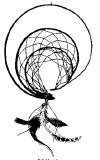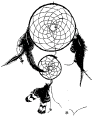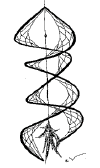Indian Tribes and
Termination
American
Indians are not all alike. Individual Indian tribes can be as different as
the United States and France. Each tribe has its own culture, language and
traditions.
A tribe is a
society of people bound by blood ties, family relations, and a common
language. Tribes also have their own religion and political system.
Today there
are 558 federally recognized tribes in the United States, including more
than 200 native villages in Alaska. Federal recognition acknowledges the
government-to-government status a tribe has within the United States, and
also provides certain federal services.
Federally
recognized tribes are considered self-governing - or sovereign Indian
nations - by Congress. So the federal government deals with tribes as
political entities, not as a certain race.
In Minnesota,
there are two Indian tribal groups: the Ojibwe (also known as the Chippewa)
and the Lakota or Dakota (also known as the Sioux). Six of the Ojibwe bands
are members of the Minnesota Chippewa Tribe. These bands are Bois Forte,
Fond du Lac, Grand Portage, Leech Lake, Mille Lacs, and White Earth. A
seventh Ojibwe band, the Red Lake Band, is separate from the Minnesota
Chippewa Tribe.
The four
Dakota or Lakota bands are: Lower Sioux, Prairie Island Sioux, Shakopee
Mdewakanton Sioux, and Upper Sioux.
Altogether,
the 11 Indian bands have more than 50,000 enrolled members. The Mille Lacs
Band of Ojibwe has about 3,100 enrolled members.
Indians and Elections
Yes, Indians have dual citizenship as tribal members and
as citizens of the United States. Tribal membership does not prevent Indians
from being Americans, and Indians have the same rights and duties as other
citizens of this country. They can vote in local and national elections and
run for public office.
Probably the best-known Indian-elected official is United
States Senator Ben Nighthorse Campbell. He is a Republican from Colorado,
and a member of the Northern Cheyenne tribe. Earlier in this century, Kaw
Indian Charles Curtis was Vice President of the United States under
President Herbert Hoover.
On the local scene, voters recently elected Loretta Kalk,
a Mille Lacs Band member, to the Kathio Township Board. She is one of the
first Indians from this region to be elected to public office.
Unbelievable as it may seem, Indians did not always have
the right to vote and run for office. Indians living within the borders of
the United States were not declared citizens of this country until 1924.
Although Indians could claim American citizenship after
1924, their rights were still limited. For example, Indians were denied
religious freedom and kept from worshipping at their sacred sites on federal
lands. Indian prisoners could see priests or ministers but not Indian
healers. Not until the Religious Freedom Act of 1978 did Indians have these
rights.
Another example: federal laws protected the cemeteries of
all American citizens except Indians. Grave robbers could steal remains and
artifacts from Indian graves until 1990, when Congress passed the Native
American Graves Protection and Repatriation Act.
Indians have always been citizens of their own nations
within this country, but it took years and many small battles to achieve the
rights that come with U.S. citizenship.
Termination
The termination era was one of the most difficult periods
American Indians ever experienced. It was an era, which roughly corresponded
to the "Eisenhower years" of the 1950s, when the United States government
tried to end trust agreements with Indians. Termination was one of many
unsuccessful attempts to "deal with the Indians" who were the first People
on this land and in this country.
Many congressmen at that time argued that the Bureau of
Indian Affairs kept Indians dependent on government. Therefore, they
suggested that Congress should sever any ties with Indians, including legal
protections and support services.
While the policy supposedly was intended to help Indians
become self-sufficient, the result was completely the opposite. Indians were
reduced to surviving on the barest of necessities, and their suffering was
almost beyond human comprehension. Tribes were suddenly left to finance
education, health care, and other services, with depleted or non-existent
trust funds. The idea of tribal self-government was nearly non-existent.
The Mille Lacs Indians suffered in many other ways during
the termination era. Their treaty rights were ignored, their businesses
stopped receiving assistance, and they lost any voice in federal or state
government.
At the same time, Congress passed Public Law 280 which
gave the United States government jurisdiction over criminal and civil laws
on Indian reservations. As a result, Mille Lacs Indians were frequently
subject to harsher treatment and longer sentences under criminal law than
non-Indians. Indian children often were placed in foster homes or adopted,
and state officials ignored tribal hunting and fishing rights, causing
wide-spread hunger and even starvation.
The termination policies of the 1950s also encouraged
Indians to leave their homes and move to cities in order to find jobs. The
termination era officially ended in 1959, but the effects of this policy,
which left crushing poverty and a weakened economic system, lasted for a
much longer time. Not until the last decade have the Mille Lacs Band members
and other Indians been able to start to turn the devastation of the 1950s
around.
White Eagle Soaring: Dream Dancer of the 7th Fire







 Get
a course to promote your business online, explode your sales
Get
a course to promote your business online, explode your sales Get
software to promote your business online in less time
Get
software to promote your business online in less time Get
software to streamline your business and run it hands free.
Get
software to streamline your business and run it hands free.